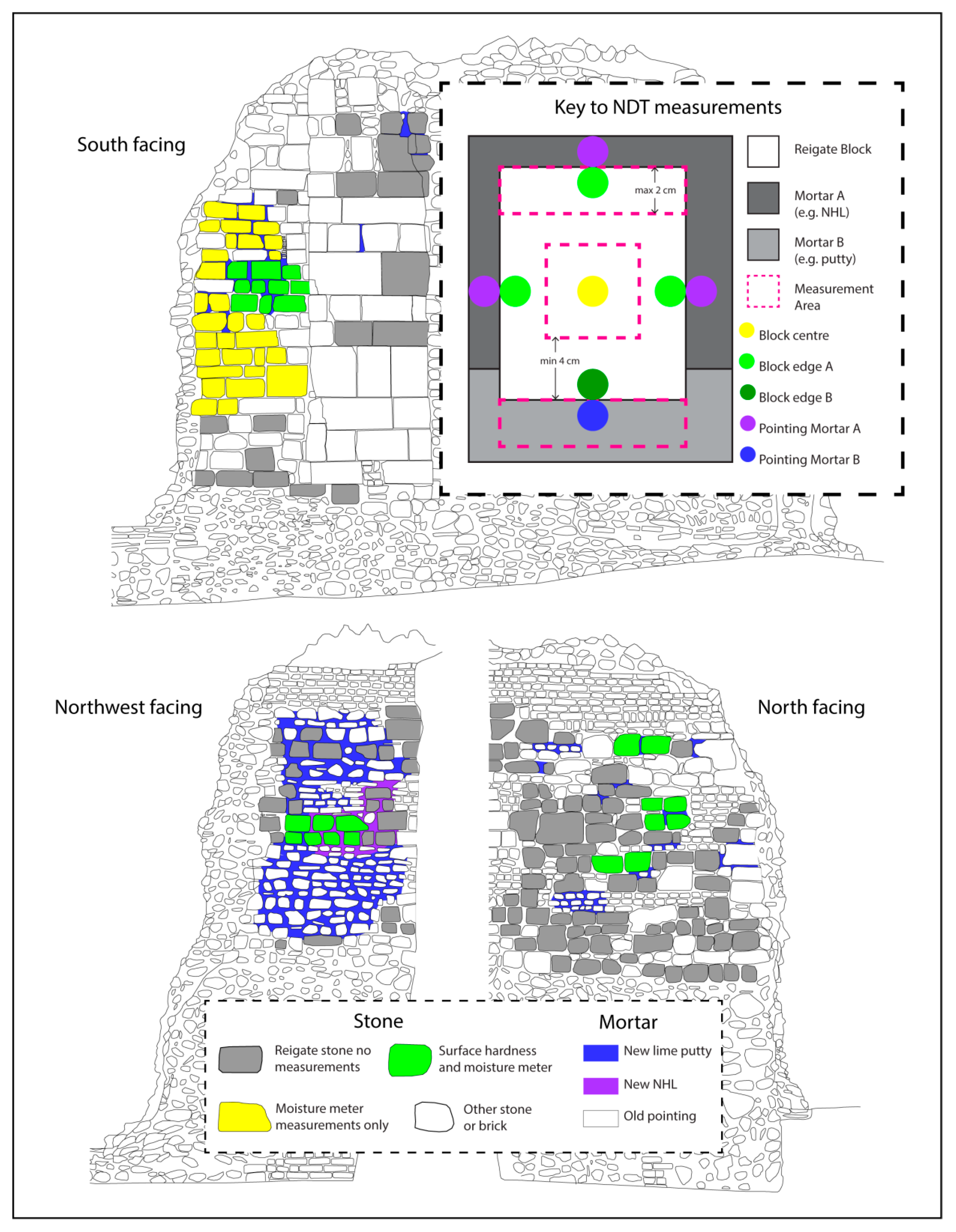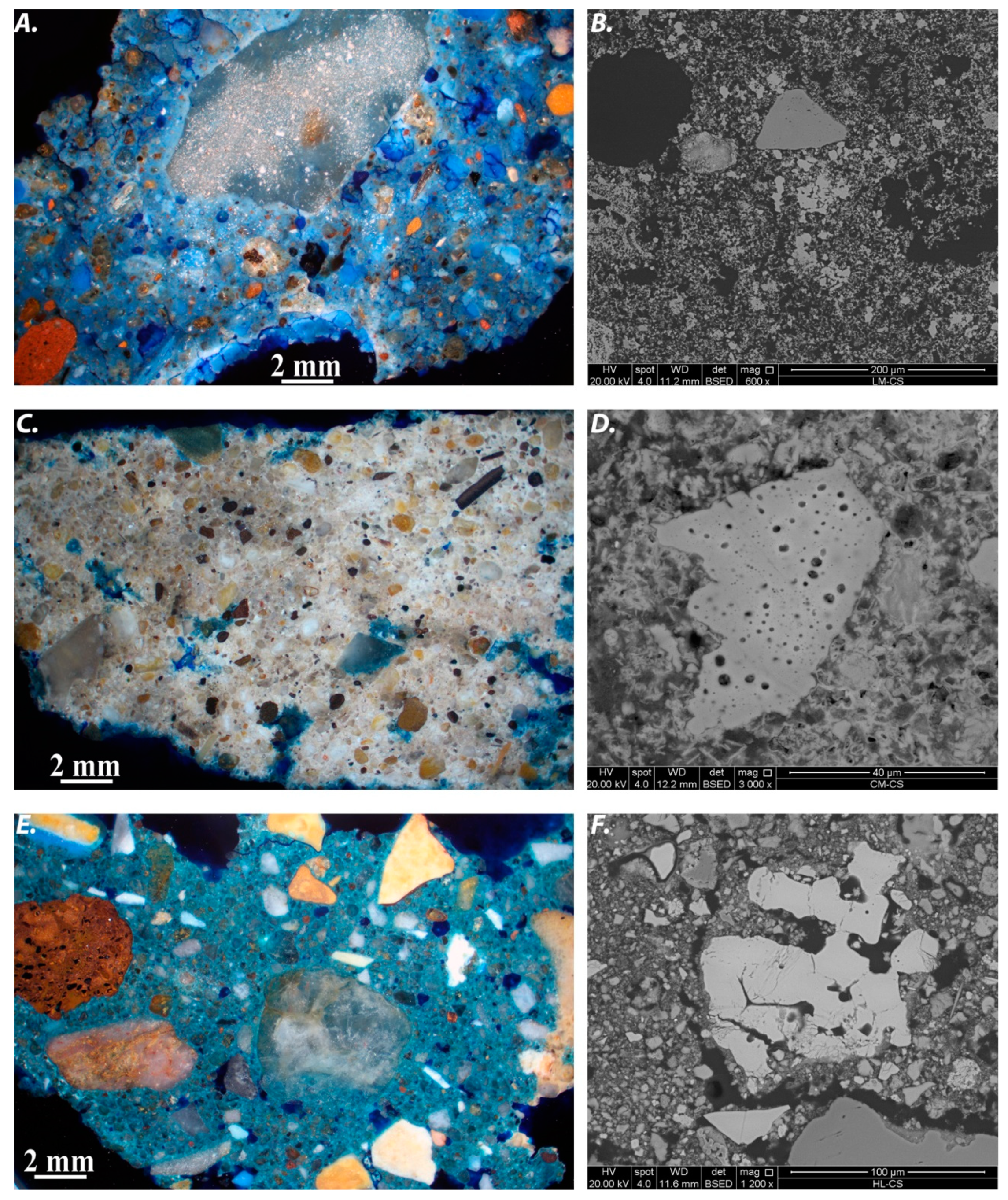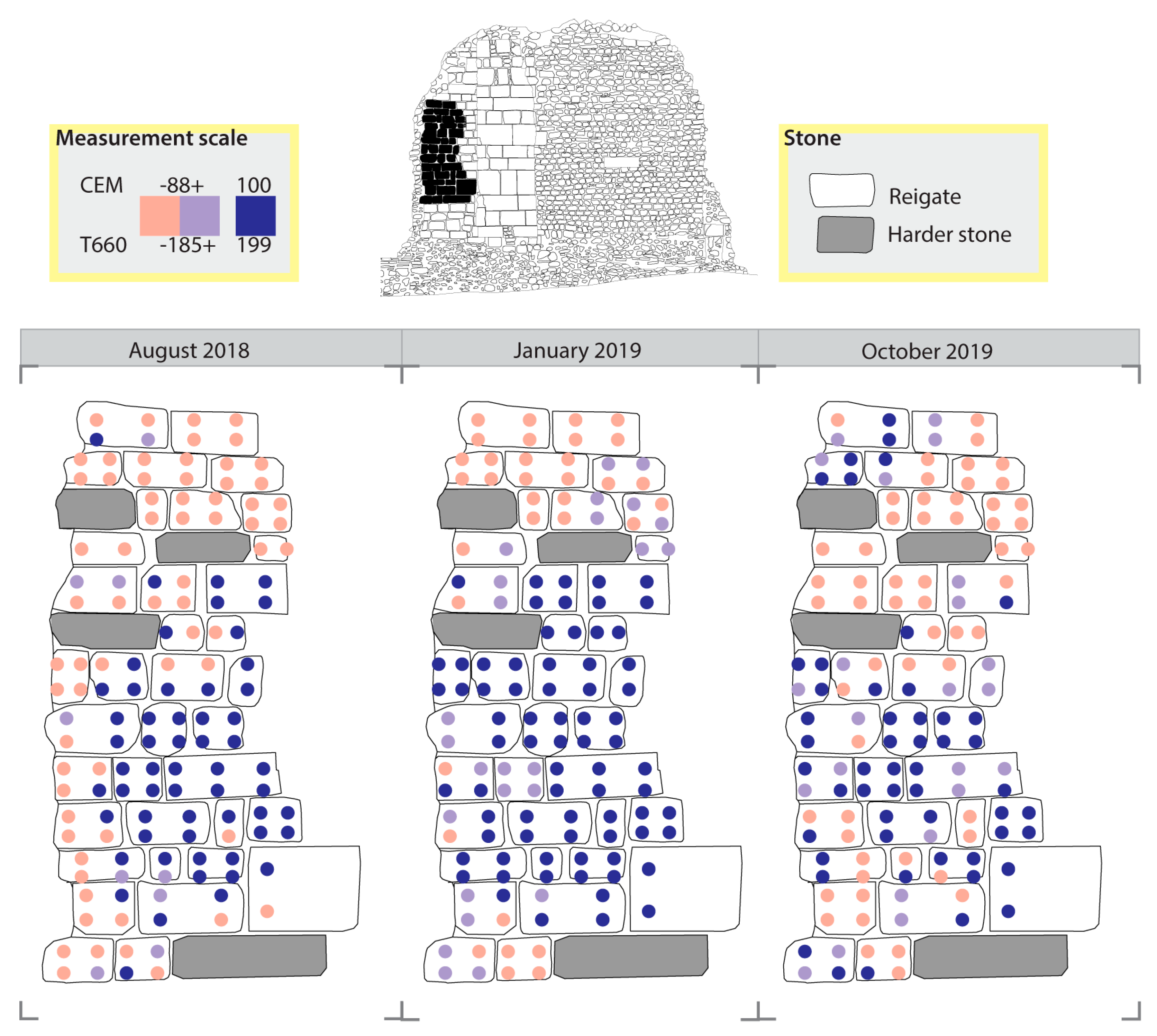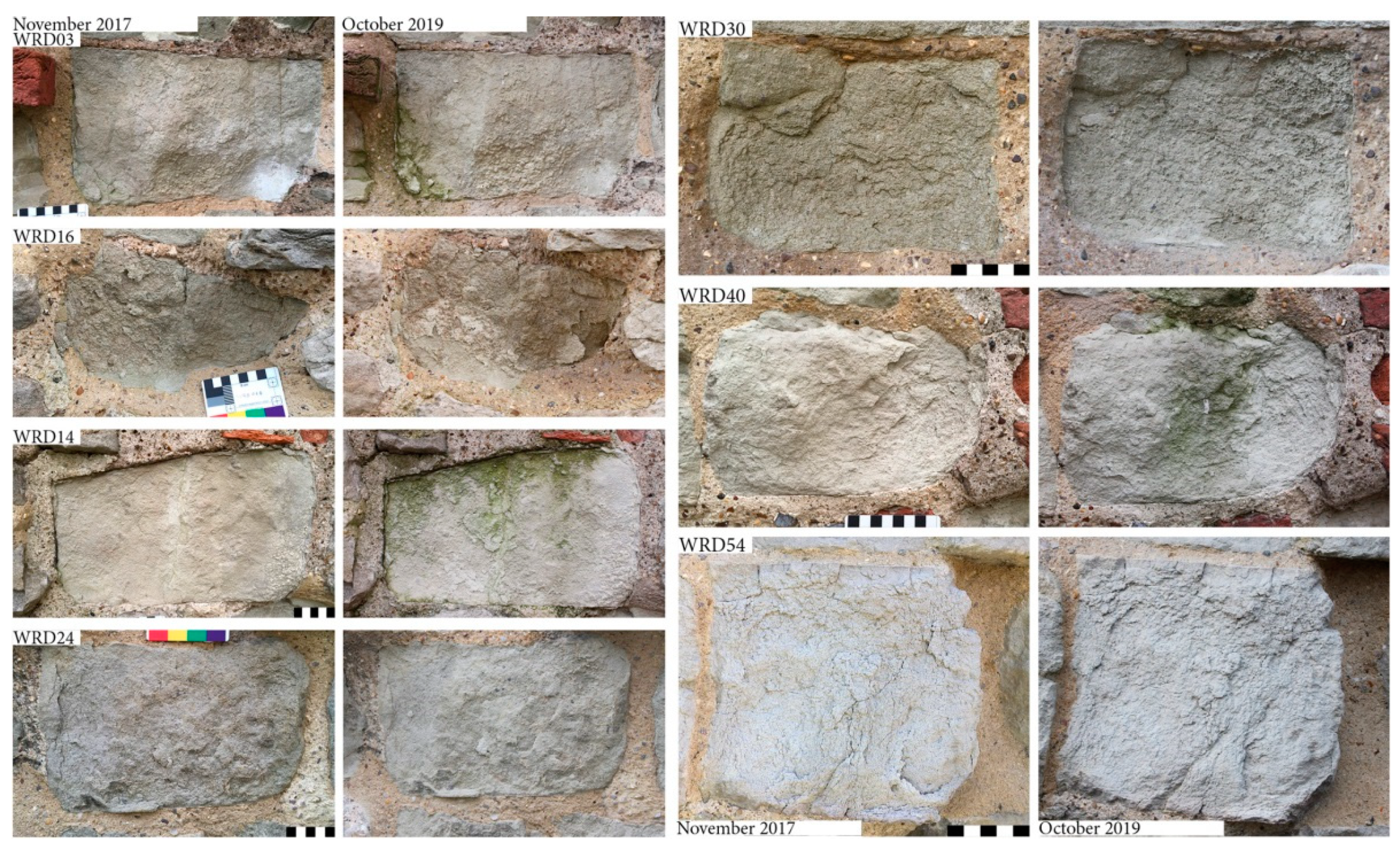In Situ, Non-Destructive Testing for Evaluating the Role of Pointing Mortar in Preventive Conservation Strategies. A Case-Study on Reigate Stone at the Wardrobe Tower, Tower of London
Abstract
:1. Introduction
- How can NDT best be used to determine the effect of pointing mortar on surrounding masonry?
- Is there a discernible difference between the performance of different pointing mortar recipes used in Reigate Stone conservation?
- Does pointing mortar constitute a measurable control on the decay of the Wardrobe Tower?
1.1. Pointing Mortars in Building Conservation
1.2. Non-Destructive Testing (NDT)
2. Site and Methods
2.1. Wardrobe Tower
2.1.1. Construction and Conservation
2.1.2. Present Condition
- The entire western flank of south facing ashlar masonry. The upper part of this area was more extensively repointed in 2017; the lower part was left with extant pointing mortar, believed to date to the 1995 work.
- An area of ashlar interspaced with brick courses at the upper eastern flank of north facing masonry. This area was almost entirely repointed in 2017, and it includes the area repointed with NHL.
- A large area of ashlar and rubble interspaced with brick courses and other stone types, covering the upper half of the central and western parts of north facing masonry. This area was only partially repointed in 2017 and contains a patchwork of older pointing mortars.
2.1.3. Material Composition
2.2. Methodology
2.2.1. Field Surveys
- Type and condition of pointing mortar. Condition was initially determined based on bond, width and profile. Type was defined as one of three categories:
- New lime putty mortar used in April 2017 conservation.
- New NHL applied to test area in April 2017.
- Old pointing mortar. Treated as one group. In situ differentiation of pointing mortars was not always possible due to discolouration. Two historic mortars analysed in previous section likely to be representative of joints surveyed.
- Contextual factors, including aspect, height and adjacent masonry.
2.2.2. Non-Destructive Testing (NDT)
3. Results and Discussion
3.1. Overview
3.2. Capacitance Meter Measurements
3.2.1. Local Distribution
3.2.2. General Distribution
3.3. Surface Hardness Measurements
3.3.1. General Distribution
- Date of survey. SH data from the November 2017, August 2018 and January 2019 surveys were included to be representative of different wetting and drying scenarios.
- Aspect. The data were grouped into north and south, to evaluate the role of exposure across the different wetting and drying scenarios.
- Mortar. The data were grouped into all measurements taken along edges adjoining specific mortar types (i.e., putty, NHL or old mortar) or at the centres of all blocks.
- Block. The data were grouped into all measurements taken on a single block.
3.3.2. Local Distribution
3.4. Material Context
3.5. Synthesis
4. Conclusions
Author Contributions
Funding
Acknowledgments
Conflicts of Interest
References
- Torney, C.; Forster, A.M.; Szadurski, E.M. Specialist ‘restoration mortars’ for stone elements: A comparison of the physical properties of two stone repair materials. Herit. Sci. 2014, 2, 1. [Google Scholar] [CrossRef] [Green Version]
- Fusade, L.; Viles, H.A. A comparison of standard and realistic curing conditions of natural hydraulic lime repointing mortar for damp masonry: Impact on laboratory evaluation. J. Cult. Herit. 2019, 37, 82–93. [Google Scholar] [CrossRef]
- Elert, K.; Rodriguez-Navarro, C.; Pardo, E.S.; Hansen, E.; Cazalla, O. Lime mortars for the conservation of historic buildings. Stud. Conserv. 2002, 47, 62–75. [Google Scholar]
- Forster, A. Hot-lime mortars: A current perspective. J. Archit. Conserv. 2004, 10, 7–27. [Google Scholar] [CrossRef]
- Fusade, L.; Viles, H.; Wood, C.; Burns, C. The effect of wood ash on the properties and durability of lime mortar for repointing damp historic buildings. Constr. Build. Mater. 2019, 212, 500–513. [Google Scholar] [CrossRef]
- Erkal, A.; D’Ayala, D. Laboratory testing of non-standard original historic building materials and related implications for conservation. Q. J. Eng. Geol. Hydrogeol. 2015, 48, 15–28. [Google Scholar] [CrossRef]
- Michette, M.; Viles, H.; Vlachou, C.; Angus, I. The many faces of Reigate Stone: An assessment of variability in historic masonry based on Medieval London’s principal freestone. Herit. Sci. 2020, 8, 80. [Google Scholar] [CrossRef]
- Sowan, P.W. Firestone and hearthstone mines in the Upper Greensand of east Surrey. Proc. Geol. Assoc. 1975, 86, 571–591. [Google Scholar] [CrossRef]
- Michette, M.; Viles, H.; Vlachou-Mogire, C.; Angus, I. Assessing the Long-term Success of Reigate Stone Conservation at Hampton Court Palace and the Tower of London. Stud. Conserv. 2020, 65, 225–232. [Google Scholar] [CrossRef] [Green Version]
- Erkal, A.; D’Ayala, D.; Sequeira, L. Assessment of wind-driven rain impact, related surface erosion and surface strength reduction of historic building materials. Build. Environ. 2012, 57, 336–348. [Google Scholar] [CrossRef] [Green Version]
- Sanderson, R.; Garner, K. Conservation of Reigate Stone at Hampton Court Palace and HM Tower of London. J. Archit. Conserv. 2001, 7, 7–23. [Google Scholar] [CrossRef]
- Orr, S.A.; Young, M.; Stelfox, D.; Curran, J.; Viles, H. Wind-driven rain and future risk to build heritage in the United Kingdom: Novel metrics for characterising rain spells. Sci. Total Environ. 2018, 640, 1098–1111. [Google Scholar] [CrossRef] [PubMed]
- Fusade, L.; Orr, S.A.; Wood, C.; O’Dowd, M.; Viles, H. Drying response of lime-mortar joints in granite masonry after an intense rainfall and after repointing. Herit. Sci. 2019, 7, 38. [Google Scholar] [CrossRef] [Green Version]
- Charola, A.E. Salts in the deterioration of porous materials: An overview. J. Am. Inst. Conserv. 2000, 39, 327–343. [Google Scholar] [CrossRef]
- Wangler, T.; Scherer, G.W. Clay swelling mechanism in clay-bearing sandstones. Environ. Geol. 2008, 56, 529–534. [Google Scholar] [CrossRef]
- Wiggins, D. Traditional lime mortars and masonry preservation. J. Build. Limes Forum 2017, 24, 28–37. [Google Scholar]
- Henry, A.; Stewart, J. Mortars, Renders and Plasters. In Practical Building Conservation, 1st ed.; Henry, A., Stewart, J., Eds.; Historic England: Swindon/London, UK, 2011. [Google Scholar]
- Maurenbrecher, P. RILEM TC 203-RHM: Repair mortars for historic masonry: Requirements for repointing mortars for historic masonry. Mater. Struct. 2012, 45, 1303–1309. [Google Scholar]
- Weber, J.; Gadermayr, N.; Bayer, K.; Hughes, D.; Kozlowski, R.; Stillhammerova, M.; Vyskocilova, R. Roman cement mortars in Europe’s architectural heritage of the 19th century. In Natural Cement; ASTM International: West Conshohocken, PA, USA, 2008. [Google Scholar]
- Urquhart, D.C.M.; Young, M.E.; MacDonald, J.; Jones, M.S.; Nicholson, K.A. Aberdeen granite buildings: A study of soiling and decay. In Processes of Urban Stone Decay; Routledge: London, UK, 1996; p. 76. [Google Scholar]
- McCabe, S.; Smith, B.J.; Warke, P.A. A legacy of mistreatment: Conceptualizing the decay of medieval sandstones in NE Ireland. Geol. Soc. Lond. Spec. Publ. 2010, 333, 87–100. [Google Scholar] [CrossRef]
- Odgers, D.; Henry, A.; Martin, B.; Wood, C. Stone by English Heritage. In Practical Building Conservation; Historic England: Swindon/London, UK, 2012. [Google Scholar]
- McCann, D.M.; Forde, M.C. Review of NDT methods in the assessment of concrete and masonry structures. NDT E Int. 2001, 34, 71–84. [Google Scholar] [CrossRef]
- Moropoulou, A.; Labropoulos, K.C.; Delegou, E.T.; Karoglou, M.; Bakolas, A. Non-destructive techniques as a tool for the protection of built cultural heritage. Constr. Build. Mater. 2013, 48, 1222–1239. [Google Scholar] [CrossRef]
- Madariaga, J.M.; Maguregui, M.; De Vallejuelo, S.F.O.; Knuutinen, U.; Castro, K.; Martinez-Arkarazo, I.; Pitarch, A. In situ analysis with portable Raman and ED-XRF spectrometers for the diagnosis of the formation of efflorescence on walls and wall paintings of the Insula IX 3 (Pompeii, Italy). J. Raman Spectrosc. 2014, 45, 1059–1067. [Google Scholar] [CrossRef]
- Arrizabalaga, I.; Gómez-Laserna, O.; Carrero, J.A.; Bustamante, J.; Rodríguez, A.; Arana, G.; Madariaga, J.M. Diffuse reflectance FTIR database for the interpretation of the spectra obtained with a handheld device on built heritage materials. Anal. Methods 2015, 7, 1061–1070. [Google Scholar] [CrossRef]
- Drdácký, M.; Slížková, Z. Enhanced affordable methods for assessing material characteristics and consolidation effects on stone and mortar. J. Geophys. Eng. 2013, 10, 064005. [Google Scholar] [CrossRef]
- Franković, M.; Novaković, N.; Matović, V. Damage quantification of built stone on Dark Gate (Belgrade, Serbia): Sample of damage index application for decay rate evaluation. Environ. Earth Sci. 2015, 73, 6181–6193. [Google Scholar] [CrossRef]
- Hendrickx, R. Using the Karsten Tube to estimate water transport parameters of porous building materials. Mater. Struct. 2012, 46, 1309–1320. [Google Scholar] [CrossRef]
- Scrivano, S.; Gaggero, L. Non-invasive analytical technique to address water uptake on stone surfaces: The implemented Contact Sponge Method (i-CSM). J. Cult. Herit. 2017, 28, 9–15. [Google Scholar] [CrossRef]
- Scrivano, S.; Gaggero, L.; Gonzalez, A.Y.; Aguilar, J.G. Assessing surface weathering by revision and implementation of the peeling-test: In situ sampling and integrated analyses. J. Cult. Herit. 2017, 27, 88–96. [Google Scholar] [CrossRef]
- Viles, H.; Goudie, A.; Grab, S.; Lalley, J. The use of the Schmidt Hammer and Equotip for rock hardness assessment in geomorphology and heritage science: A comparative analysis. Earth Surf. Process. Landf. 2011, 36, 320–333. [Google Scholar] [CrossRef]
- Wilhelm, K.; Viles, H.; Burke, Ó. Low impact surface hardness testing (Equotip) on porous surfaces–advances in methodology with implications for rock weathering and stone deterioration research. Earth Surf. Process. Landf. 2016, 41, 1027–1038. [Google Scholar] [CrossRef]
- Eklund, J.A.; Zhang, H.; Viles, H.A.; Curteis, T. Using handheld moisture meters on limestone: Factors affecting performance and guidelines for best practice. Int. J. Archit. Herit. 2013, 7, 207–224. [Google Scholar] [CrossRef]
- Camuffo, D.; Bertolin, C. Towards standardisation of moisture content measurement in cultural heritage materials. e-Preserv. Sci. 2012, 9, 23–35. [Google Scholar]
- Aoki, H.; Matsukura, Y. A new technique for non-destructive field measurement of rock-surface strength: An application of the Equotip hardness tester to weathering studies. Earth Surf. Process. Landf. J. Br. Geomorphol. Res. Group 2007, 32, 1759–1769. [Google Scholar] [CrossRef] [Green Version]
- Yılmaz, N.G. The influence of testing procedures on uniaxial compressive strength prediction of carbonate rocks from Equotip hardness tester (EHT) and proposal of a new testing methodology: Hybrid dynamic hardness (HDH). Rock Mech. Rock Eng. 2013, 46, 95–106. [Google Scholar] [CrossRef]
- Fort, R.; de Buergo, M.A.; Perez-Monserrat, E.M. Non-destructive testing for the assessment of granite decay in heritage structures compared to quarry stone. Int. J. Rock Mech. Min. Sci. 2013, 61, 296–305. [Google Scholar] [CrossRef] [Green Version]
- Wilhelm, K.; Viles, H.; Burke, O.; Mayaud, J. Surface hardness as a proxy for weathering behaviour of limestone heritage: A case study on dated headstones on the Isle of Portland, UK. Environ. Earth Sci. 2016, 75, 931. [Google Scholar] [CrossRef]
- Orr, S.A.; Young, M.; Stelfox, D.; Leslie, A.; Curran, J.; Viles, H. An ‘isolated diffusion’ gravimetric calibration procedure for radar and microwave moisture measurement in porous building stone. J. Appl. Geophys. 2019, 163, 1–12. [Google Scholar] [CrossRef]
- Viles, H.A. Durability and conservation of stone: Coping with complexity. Q. J. Eng. Geol. Hydrogeol. 2013, 46, 367–375. [Google Scholar] [CrossRef]
- Michette, M.; Bichlmair, S.; Kilian, R. Diagnosing Decay Mechanisms at the Porta Nocera Necropolis, Pompeii: The First Step towards Effective Preventive Conservation. Stud. Conserv. 2018, 63 (Suppl. 1), 195–202. [Google Scholar] [CrossRef]
- Sass, O.; Viles, H.A. Wetting and drying of masonry walls: 2D-resistivity monitoring of driving rain experiments on historic stonework in Oxford, UK. J. Appl. Geophys. 2010, 70, 72–83. [Google Scholar] [CrossRef]
- De Boever, W.; Bultreys, T.; Derluyn, H.; Van Hoorebeke, L.; Cnudde, V. Comparison between traditional laboratory tests, permeability measurements and CT-based fluid flow modelling for cultural heritage applications. Sci. Total Environ. 2016, 554, 102–112. [Google Scholar] [CrossRef]
- Tatton-Brown, T. Medieval building stone at the Tower of London. Lond. Archaeol. 1991, 6, 361. [Google Scholar]
- Compton, C.H. Recent Discoveries at the Tower of London. J. Br. Archaeol. Assoc. First Ser. 1881, 37, 279–284. [Google Scholar] [CrossRef]
- Ateeq, H.; Roberts, G. Statement of Significance: Wardrobe Tower, Tower of London; unpublished report; Historic Royal Palaces: London, UK, 2017. [Google Scholar]
- Parnell, G. Book of the Tower of London; BT Batsford: London, UK, 1993. [Google Scholar]
- Drdácký, M.; Lesák, J.; Niedoba, K.; Valach, J. Peeling tests for assessing the cohesion and consolidation characteristics of mortar and render surfaces. Mater. Struct. 2015, 48, 1947–1963. [Google Scholar] [CrossRef]
- Michette, M.; Viles, H.; Vlachou, C.; Angus, I. Bellweathered: Reigate Stone Decay Mechanisms at the Bell Tower, Tower of London. Monum. Monum. 2019, 2019, 53–64. [Google Scholar]
- Wilhelm, K.; Viles, H.; Burke, Ò. The influence of salt on handheld electrical moisture meters: Can they be used to detect salt problems in porous stone? Int. J. Archit. Herit. 2016, 10, 735–748. [Google Scholar] [CrossRef]
- Desarnaud, J.; Kiriyama, K.; Bicer Simsir, B.; Wilhelm, K.; Viles, H. A laboratory study of Equotip surface hardness measurements on a range of sandstones: What influences the values and what do they mean? Earth Surf. Process. Landf. 2019, 44, 1419–1429. [Google Scholar] [CrossRef]











| Survey Date | Summary of Environmental Conditions | Conditions in Preceding 2-Week Period | Most Recent Rainfall and Wind Direction before Survey | Drying Conditions during Survey |
|---|---|---|---|---|
| November 2017 14.11–16.11.17 | Prolonged wetting and poor drying | Relative humidity (RH) above 70%, temperature around 10 °C. Repeated rainfall. | Series of heavy spells on the 10.11 and 11.11, in which a total of 18 mm fell (peaking at 8 mm in one hour). Light winds. | Temp and RH stable. Average solar radiation was 100–150 W/m2. Light rainfall. |
| May 2018 3.05–4.05.18 | Prolonged wetting and good drying | RH above 70%, temperatures around 10 °C. Prolonged rainfall. | Heavy, wind driven spell in which 5 mm fell in 5 h on 2.05. Wind direction varying from S to NWW at speeds of up to 5 m/s. | RH below 70%, daytime temperature rose to 20 °C, with average solar radiation of 500–600 W/m2. No rainfall. |
| August 2018 12.08–13.08.18 | Rapid, heavy wetting and good drying | RH under 80%, daytime temperatures between 20 °C and 30 °C. No rainfall before 09.08. | Heavy, wind-driven rain on 9.08 and 10.08, with 25 mm falling in a series of spells with SSW wind direction (peaking at 8.5 mm in 20 min with wind speeds of 6.5 m/s). | Daytime temperature 18 °C with average solar radiation of 250–300 W/m2. No rainfall. |
| January 2019 20.01–22.01.19 | Mild wetting and poor drying | RH mostly above 70%, temperature below 10 °C. Little rainfall. | 2 mm falling on 16th and 17th January in a series of light spells. | Temp and RH stable. Average solar radiation was 150–250 W/m2. |
| October 2019 30.09–2.10.19 | Recent, mild wetting | Variable RH, temperatures between 15 and 20 °C. Occasional light showers. | Several light rain spells on the first two days of the survey, with varying wind direction and speed up to 5 m/s. | |
| Survey | Areas | Used for | Total Blocks | Total Number | Stone n | Mortar Number | ||
|---|---|---|---|---|---|---|---|---|
| NHL | Put | Old | ||||||
| Nov 17 | S.1; N.1; NW.1 | Calibration | 18 | 122 | 90 | 10 | 8 | 14 |
| May 18 | S.1; N.1; N.2; N.3; NW.1 | Calibration; Spatial distribution (micro) | 12 | 355 | 180 | 21 | 74 | 80 |
| Aug 18 | S.1; S.2; N.1; NW.1 | Calibration; Spatial distribution (micro and macro) | 51 | 656 | 447 | 51 | 87 | 71 |
| Jan 19 | S.1; S.2; N.1; N.2; N.3; NW.1 | Calibration; Spatial distribution (micro and macro) | 55 | 555 | 507 | 36 | 57 | 90 |
| Oct 19 | S.2 | Spatial distribution (macro) | 30 | 132 | 132 | n.a. | ||
| Survey | Areas | Used for | Total Blocks | Total Number | Stone n | Mortar n | |||||||
|---|---|---|---|---|---|---|---|---|---|---|---|---|---|
| By Type | By Aspect | NHL | Put | Old | |||||||||
| Centre | NHL | Put | Old | N | S | ||||||||
| Nov 17 | S.1; N.1; NW.1 | Calibration; ANOVA | 18 | 710 | 90 | 70 | 135 | 155 | 280 | 170 | 50 | 85 | 125 |
| May 18 | N.1; N.2; N.3 | Calibration | 10 | 494 | 110 | n.a. | 224 | 160 | 494 | n.a. | n.a. | ||
| Aug 18 | S.1; N.1; NW.1 | ANOVA; Spatial distribution | 21 | 1410 | 174 | 162 | 264 | 270 | 570 | 300 | 126 | 228 | 186 |
| Jan 19 | S.1; N.1; N.2; N.3; NW.1 | ANOVA; Spatial distribution | 22 | 1009 | 129 | 123 | 173 | 221 | 436 | 210 | 72 | 112 | 179 |
| Oct 19 | Not used | n.a. | |||||||||||
| All Dates | November 2017 | August 2018 | January 2019 | |||||||||
|---|---|---|---|---|---|---|---|---|---|---|---|---|
| Df | F Value | Pr (>F) | Df | F Value | Pr (>F) | Df | F Value | Pr (>F) | Df | F Value | Pr (>F) | |
| Date | 2 | 46.32 | <2 × 10−16 | - | - | - | - | - | - | - | - | - |
| Aspect | 1 | 40.43 | 2.67 × 10−10 | 1 | 14 | 0.0002 | 1 | 30.34 | 5.50 × 10−8 | 1 | 9.18 | 0.0026 |
| Mortar | 3 | 6.28 | 0.0003 | 3 | 0.8 | 0.5 | 3 | 6.72 | 0.0002 | 3 | 1.13 | 0.34 |
| Block * | - | - | - | 16 | 4.65 | 1.38 × 10−8 ** | 16 | 6.1 | 1.50 × 10−12 | - | - | - |
| Date:Aspect | 2 | 1.08 | 0.34 | - | - | - | - | - | - | - | - | - |
| Date:Mortar | 6 | 0.87 | 0.52 | - | - | - | - | - | - | - | - | - |
| Aspect:Mortar | 2 | 1.07 | 0.34 | 2 | 0.71 | 0.49 | 2 | 0.5 | 0.61 | 2 | 0.66 | 0.52 |
| Mortar:Block * | - | - | - | 24 | 2.26 | 0.0007 ** | 24 | 2.7 | 2.92 × 10−5 | - | - | - |
| Date:Aspect:Mortar | 4 | 1.2 | 0.31 | - | - | - | - | - | - | - | - | - |
| Residuals | 1560 | 377 | 572 | 531 | ||||||||
| Material | Total Number | Average (HLD) | StdDev (HLD) |
|---|---|---|---|
| NHL joint | 132 | 327.8 | 100.6 |
| Old joint | 293 | 277.5 | 63.9 |
| Putty joint | 216 | 284.3 | 75.9 |
| Reigate | 1186 | 315.0 | 64.2 |
Publisher’s Note: MDPI stays neutral with regard to jurisdictional claims in published maps and institutional affiliations. |
© 2021 by the authors. Licensee MDPI, Basel, Switzerland. This article is an open access article distributed under the terms and conditions of the Creative Commons Attribution (CC BY) license (http://creativecommons.org/licenses/by/4.0/).
Share and Cite
Michette, M.; Viles, H.; Vlachou, C.; Angus, I. In Situ, Non-Destructive Testing for Evaluating the Role of Pointing Mortar in Preventive Conservation Strategies. A Case-Study on Reigate Stone at the Wardrobe Tower, Tower of London. Minerals 2021, 11, 345. https://doi.org/10.3390/min11040345
Michette M, Viles H, Vlachou C, Angus I. In Situ, Non-Destructive Testing for Evaluating the Role of Pointing Mortar in Preventive Conservation Strategies. A Case-Study on Reigate Stone at the Wardrobe Tower, Tower of London. Minerals. 2021; 11(4):345. https://doi.org/10.3390/min11040345
Chicago/Turabian StyleMichette, Martin, Heather Viles, Constantina Vlachou, and Ian Angus. 2021. "In Situ, Non-Destructive Testing for Evaluating the Role of Pointing Mortar in Preventive Conservation Strategies. A Case-Study on Reigate Stone at the Wardrobe Tower, Tower of London" Minerals 11, no. 4: 345. https://doi.org/10.3390/min11040345
APA StyleMichette, M., Viles, H., Vlachou, C., & Angus, I. (2021). In Situ, Non-Destructive Testing for Evaluating the Role of Pointing Mortar in Preventive Conservation Strategies. A Case-Study on Reigate Stone at the Wardrobe Tower, Tower of London. Minerals, 11(4), 345. https://doi.org/10.3390/min11040345






